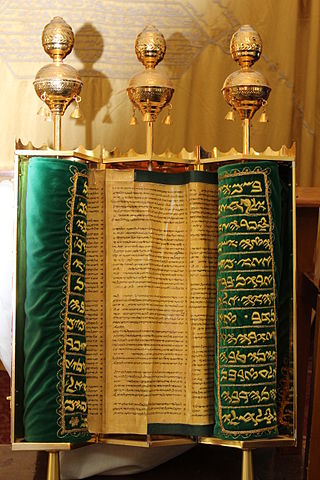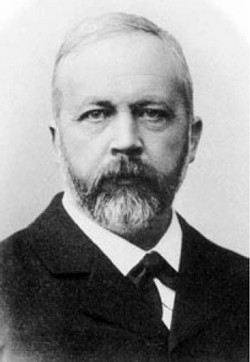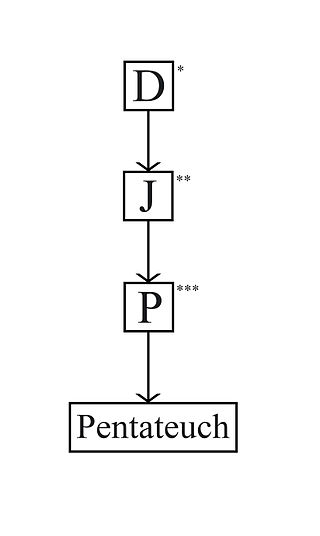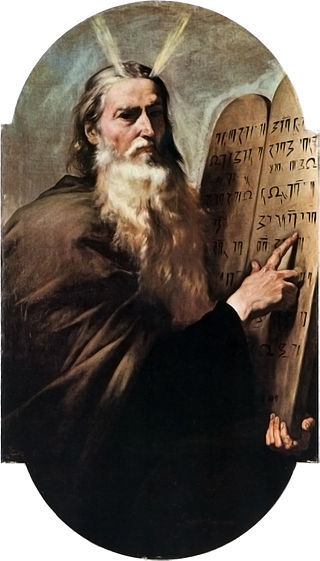Related Research Articles
The Book of Numbers is the fourth book of the Hebrew Bible and the fourth of five books of the Jewish Torah. The book has a long and complex history; its final form is possibly due to a Priestly redaction of a Yahwistic source made sometime in the early Persian period. The name of the book comes from the two censuses taken of the Israelites.

Deuteronomy is the fifth book of the Torah, where it is called Devarim and the fifth book of the Hebrew Bible and Christian Old Testament.
The Old Testament (OT) is the first division of the Christian biblical canon, which is based primarily upon the 24 books of the Hebrew Bible, or Tanakh, a collection of ancient religious Hebrew and occasionally Aramaic writings by the Israelites. The second division of Christian Bibles is the New Testament, written in Koine Greek.

Samaritanism is an Abrahamic monotheistic ethnic religion. It comprises the collective spiritual, cultural, and legal traditions of the Samaritan people, who originate from the Hebrews and Israelites and began to emerge as a relatively distinct group after the Kingdom of Israel was conquered by the Neo-Assyrian Empire during the Iron Age. Central to the faith is the Samaritan Pentateuch, which Samaritans believe is the original and unchanged version of the Torah.

The Torah is the compilation of the first five books of the Hebrew Bible, namely the books of Genesis, Exodus, Leviticus, Numbers and Deuteronomy. In Christianity, the Torah is also known as the Pentateuch or the Five Books of Moses. In Rabbinical Jewish tradition it is also known as the Written Torah. If meant for liturgic purposes, it takes the form of a Torah scroll. If in bound book form, it is called Chumash, and is usually printed with the rabbinic commentaries.
The Nevi'im is the second major division of the Hebrew Bible, lying between the Torah and Ketuvim. The Nevi'im are divided into two groups. The Former Prophets consists of the narrative books of Joshua, Judges, Samuel and Kings; while the Latter Prophets include the books of Isaiah, Jeremiah, Ezekiel, and the Twelve Minor Prophets.

The documentary hypothesis (DH) is one of the models used by biblical scholars to explain the origins and composition of the Torah. A version of the documentary hypothesis, frequently identified with the German scholar Julius Wellhausen, was almost universally accepted for most of the 20th century. It posited that the Pentateuch is a compilation of four originally independent documents: the Jahwist, Elohist, Deuteronomist, and Priestly sources, frequently referred to by their initials. The first of these, J, was dated to the Solomonic period. E was dated somewhat later, in the 9th century BCE, and D was dated just before the reign of King Josiah, in the 7th or 8th century BCE. Finally, P was generally dated to the time of Ezra in the 5th century BCE. The sources would have been joined at various points in time by a series of editors or "redactors".

Julius Wellhausen was a German biblical scholar and orientalist. In the course of his career, his research interest moved from Old Testament research through Islamic studies to New Testament scholarship. Wellhausen contributed to the composition history of the Pentateuch/Torah and studied the formative period of Islam. For the former, he is credited as one of the originators of the documentary hypothesis.

The Law of Moses, also called the Mosaic Law, is the law said to have been revealed to Moses by God. The term primarily refers to the Torah or the first five books of the Hebrew Bible.
Martin Noth was a German scholar of the Hebrew Bible who specialized in the pre-Exilic history of the Hebrews and promoted the hypothesis that the Israelite tribes in the immediate period after the settlement in Canaan were organised as a group of twelve tribes arranged around a central sanctuary on the lines of the later Greek and Italian amphictyonies. With Gerhard von Rad he pioneered the traditional-historical approach to biblical studies, emphasising the role of oral traditions in the formation of the biblical texts.

The Priestly source is perhaps the most widely recognized of the sources underlying the Torah, both stylistically and theologically distinct from other material in it. It is considered by most scholars as the latest of all sources, and “meant to be a kind of redactional layer to hold the entirety of the Pentateuch together,” It includes a set of claims that are contradicted by non-Priestly passages and therefore uniquely characteristic: no sacrifice before the institution is ordained by Yahweh (God) at Sinai, the exalted status of Aaron and the priesthood, and the use of the divine title El Shaddai before God reveals his name to Moses, to name a few.

Mount Ebal is one of the two mountains in the immediate vicinity of the city of Nablus in the West Bank, and forms the northern side of the valley in which Nablus is situated, the southern side being formed by Mount Gerizim. The mountain is one of the highest peaks in the West Bank and rises to 935 m (3,068 ft) above sea level, some 60 m (200 ft) higher than Mount Gerizim. Mount Ebal is approximately 17 km2 (6.6 sq mi) in area, and is composed primarily of limestone. The slopes of the mountain contain several large caverns which were probably originally quarries, and at the base towards the north are several tombs.
The Heptateuch is a name sometimes given to the first seven books of the Hebrew Bible. The seven books are Genesis, Exodus, Leviticus, Numbers, Deuteronomy, Joshua and Judges. The first four of these are sometimes called the Tetrateuch, the first five are commonly known as the Torah or the Pentateuch, the first six as the Hexateuch. With the addition of the Book of Ruth, these eight books are known as the Octateuch. The "Enneateuch" is the Heptateuch plus the Books of Samuel and the Books of Kings.

Devarim, Dvarim, or Debarim is the 44th weekly Torah portion in the annual Jewish cycle of Torah reading and the first in the Book of Deuteronomy. It comprises Deuteronomy 1:1–3:22. The parashah recounts how Moses appointed chiefs, the episode of the Twelve Spies, encounters with the Edomites and Ammonites, the conquest of Sihon and Og, and the assignment of land to the tribes of Reuben, Gad, and Manasseh.
The Octateuch is a traditional name for the first eight books of the Bible, comprising the Pentateuch, plus the Book of Joshua, the Book of Judges and the Book of Ruth. These texts make up the first eight books of the Septuagint, which provided the ordering used in traditional Christian Bibles. This order is different from that of the Masoretic Text of the Jewish Bible, where Ruth is considered part of the third section of the canon, the Ketuvim, and is found after the Song of Songs, being the second of the Five Megillot.

Mosaic authorship is the Judeo-Christian tradition that the Torah, the first five books of the Hebrew Bible/Old Testament, were dictated by God to Moses. The tradition probably began with the legalistic code of the Book of Deuteronomy and was then gradually extended until Moses, as the central character, came to be regarded not just as the mediator of law but as author of both laws and narrative.
Prolegomena zur Geschichte Israels is a book by German biblical scholar and orientalist Julius Wellhausen (1844–1918) that formulated but did not found the documentary hypothesis, a theory on the composition history of the Torah or Pentateuch. Influential and long debated, the volume is often compared for its impact in its field with Charles Darwin's 1859 work, On the Origin of Species.
The Making of the Pentateuch by R. N. Whybray, Professor of Hebrew and Old Testament Studies at the University of Hull (UK), was a major contribution to the field of Old Testament studies, and specifically to theories on the origins and composition of the Pentateuch. Its originality lay in its detailed critique of the documentary hypothesis, and it remains a standard text on many reading lists.
Ancient Hebrew writings are texts written in Biblical Hebrew using the Paleo-Hebrew alphabet before the destruction of the Second Temple in 70 CE.
The composition of the Torah was a process that involved multiple authors over an extended period of time.
References
- 1 2 3 Schmidt, Nathaniel (1905). . In Gilman, D. C.; Peck, H. T.; Colby, F. M. (eds.). New International Encyclopedia (1st ed.). New York: Dodd, Mead.
- 1 2 Benno Jacob (1904). "Hexateuch". In Isidore Singer (ed.). The Jewish Encyclopedia.
But even if there were no objections to either of these contentions, they would not be sufficient to undermine the independence and completeness of the Pentateuch, evident throughout its entire composition, and verified by an uncontradicted tradition which goes back to Biblical times. The Torah has never been connected with the Book of Joshua, and has always constituted the first part of the Bible, in contradistinction to the two other parts.